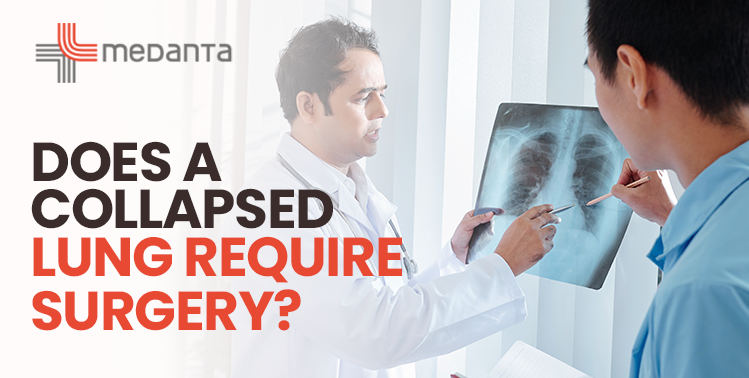CH Baktawar Singh Rd, Medicity, Islampur Colony, Sector 38, Gurugram, Haryana 122001

30 June, 2025
adminA collapsed lung is a serious medical condition. It can happen suddenly and cause sharp chest pain and difficulty in breathing. If you or someone close to you is diagnosed with a collapsed lung, one of the first questions that comes to mind is, “Does this require surgery?”
The answer is: sometimes yes, sometimes no. It depends on how serious the collapse is, what caused it, and how your body responds to treatment.
In this blog, we’ll break down everything you need to know about a collapsed lung, when surgery is needed, and how doctors decide the best treatment plan.
A collapsed lung is also known as a pneumothorax. This happens when air leaks into the space between the lung and the chest wall. This air puts pressure on the lung and causes it to collapse.
Your lungs need room to expand when you breathe. When air fills the space outside the lung, the lung can no longer expand properly, and this leads to breathing problems.
There are different types of pneumothorax. Understanding which type you have helps doctors decide whether surgery is needed.
This can happen without any clear reason. It’s more common in:
There are two typesPrimary spontaneous pneumothorax (occurs in healthy people)
This is caused by injury. It could be from:
This is the most dangerous type. It happens when air enters the chest cavity and cannot escape. The pressure keeps building, pushing the lung and even the heart. This is a medical emergency and often requires immediate surgery.
Also read: Pneumothorax Treatment Recovery: How Long Before Symptoms Go Away?
The symptoms can vary based on how much of the lung has collapsed. Common signs include:
If the lung collapse is large or causes tension, the symptoms are more severe, and emergency care is needed.
Doctors usually begin with a physical exam and then do tests like:
Your doctor will also ask about your medical history, smoking habits, injuries, or past lung problems.
Not always. The treatment depends on:
Let’s look at the different treatment options.
For a small pneumothorax without major symptoms, doctors may simply monitor you. Your body can sometimes reabsorb the air on its own in a few days.
You might be:
This is usually the approach for a first-time, small primary spontaneous pneumothorax.
If there’s more air trapped, your doctor may insert a needle into your chest to remove the air. This helps the lung re-expand. This procedure is done under local anesthesia and usually doesn’t take long.
In larger pneumothorax cases, a chest tube is inserted through your side into the pleural space. This tube allows the trapped air to escape and gives your lung room to expand again. You may need to stay in the hospital for a few days while this tube does its job.
There are situations where surgery becomes necessary. Let’s look at some of the most common ones:
If your lung collapses more than once, doctors usually recommend surgery to prevent it from happening again.
If a chest tube or needle does not fix the issue within a few days, surgery may be needed to seal the leak or remove damaged parts of the lung.
This is an emergency. It often requires immediate surgical drainage or repair to save your life.
If you have a collapsed lung due to chronic lung disease, surgery might help reduce future risks and improve lung function.
The most common surgery for a collapsed lung is:
This surgery is safer and involves a quicker recovery than traditional open chest surgery.
In some cases, the surgeon will do a pleurodesis. This is a procedure where the lung is attached to the chest wall using medicine or by scratching the pleural lining. It helps prevent future lung collapses.
Most people stay in the hospital for a few days after surgery. Full recovery takes a few weeks. You’ll need to:
Complications from surgery are rare but may include infection, pain, or a small chance of the lung collapsing again.
Not always, but you can reduce your risk by:
If you’ve had a collapsed lung before, discuss with your doctor what activities to avoid in the future.
So, does a collapsed lung require surgery? The answer depends on the size, cause, and whether it happens more than once. Many people recover without surgery, especially if it’s a small and first-time event. But in serious or repeat cases, surgery can be life-saving and prevent future problems.
If you experience symptoms of a collapsed lung—like sudden chest pain or trouble breathing, seek medical help immediately. Dr Harsh Vardan Puri can assess your condition and decide the best course of treatment.
With proper care and the right medical advice, most people recover fully from a collapsed lung and return to normal life.
Category : Pneumothorax
Tags: